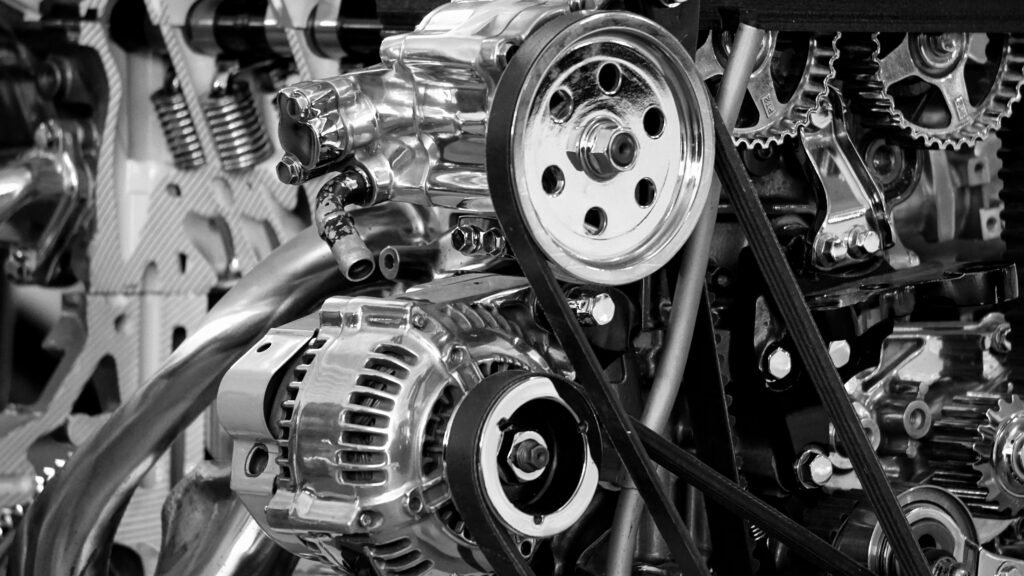
Are you encountering problems with your car’s power steering pump drive pulley? Don’t worry, we’ve got you covered! In this article, we will explore the process of diagnosing and addressing issues with this crucial component of your vehicle. From identifying common symptoms to providing practical solutions, we aim to empower you with the knowledge and know-how to get your power steering pump drive pulley back in top shape. So, let’s dive right in and get you on the road to a smoothly functioning power steering system in no time!

Overview
When it comes to the smooth and effortless steering of your car, the power steering pump drive pulley plays a crucial role. Understanding this component and being able to diagnose and address any issues promptly is vital for maintaining the overall functionality of your vehicle. In this article, we will delve into the importance of the power steering pump drive pulley, explore various signs of issues, discuss the diagnostic process, and provide step-by-step guidance on how to address these problems effectively.
Understanding the Power Steering Pump Drive Pulley
The power steering pump drive pulley is a key component of the power steering system in your car. It is responsible for transferring power from the engine to the power steering pump, which in turn generates hydraulic pressure to assist in steering. By rotating the drive belt connected to the engine crankshaft, the drive pulley enables the power steering pump to function smoothly. Without a properly functioning drive pulley, your power steering system could experience difficulties, leading to an uncomfortable and unsafe driving experience.

Importance of Diagnosing and Addressing Issues
Diagnosing and addressing issues with your car’s power steering pump drive pulley is of utmost importance. Ignoring or neglecting these issues can cause further damage to the power steering system and compromise your ability to steer the vehicle safely. By promptly identifying and addressing problems, you can avoid expensive repairs, maintain optimal steering performance, and ensure your own safety as well as the safety of others on the road.
Diagnosing Issues
To effectively address any issues with your power steering pump drive pulley, you need to be able to diagnose the problem accurately. Here are some common signs to look out for:
Unusual Noises
One of the first indicators of a problem with the drive pulley is the presence of unusual noises while steering. If you hear a squealing, screeching, or grinding sound, it could be a sign of a loose or damaged drive pulley. These noises are usually caused by the friction between the pulley and the drive belt or other components of the power steering system.
Power Steering Fluid Leakage
Another red flag to watch out for is power steering fluid leakage. If you notice a puddle of fluid under your car or see signs of fluid on the power steering pump or drive pulley, it is likely that there is a leak. Power steering fluid is crucial for the proper functioning of the system, and a leak can lead to a loss of hydraulic pressure and impaired steering performance.
Difficulty in Steering
If you find it increasingly difficult to steer your car, especially at lower speeds or while making tight turns, it could be an indication of a failing power steering pump drive pulley. The pulley’s inability to transfer power effectively may make steering feel heavier and more strenuous than usual.
Visual Inspection
A visual inspection of the drive pulley can provide valuable insights into its condition. Look for any signs of damage, such as cracks, chips, or missing pieces. Additionally, inspect the power steering system as a whole for loose or disconnected components that may be affecting the performance of the drive pulley.

Addressing Issues
Once you have successfully diagnosed an issue with your power steering pump drive pulley, it is essential to take appropriate action to address the problem promptly. Here are some possible approaches for resolving drive pulley issues:
Replacing the Power Steering Pump Drive Pulley
If the drive pulley is severely damaged or beyond repair, replacing it entirely may be the most effective solution. This process typically involves removing the old pulley and installing a new one in its place. Ensure that you have the necessary tools and materials, such as a power steering pulley puller, socket set, and a new drive pulley that is compatible with your car’s make and model.
Repairing the Drive Pulley
In some cases, the drive pulley may only have minor issues that can be repaired. For example, if there are small cracks or chips, you may be able to use epoxy or a similar adhesive to fill in the damaged areas. However, keep in mind that repairing the drive pulley is not always a long-term solution, and it may be better to opt for a replacement if the damage is significant.
Maintaining the Pulley and Power Steering System
To ensure the longevity and optimal performance of your power steering pump drive pulley, regular maintenance is essential. This includes checking the tension and alignment of the drive belt, monitoring power steering fluid levels, and promptly addressing any issues that arise. Regular inspections and preventative maintenance can help you catch problems early on and avoid more severe issues down the line.
Tools and Materials Needed
To diagnose and address issues with your car’s power steering pump drive pulley effectively, it is essential to have the appropriate tools and materials on hand. Here are some commonly used items:
- Power steering pulley puller
- Socket set
- Power steering fluid
- Ratchet wrench
- Hydraulic jack
- Jack stands
- Wrench set
By ensuring that you have the necessary tools and materials, you can tackle the diagnostic and repair process with confidence and efficiency.
Step 1: Safety Precautions
Before diving into any repairs or diagnostics, it is crucial to prioritize safety. Here are some essential safety precautions to observe:
Park the Car on a Level Surface
Ensure that your car is parked on a flat and stable surface to prevent any unwanted movement.
Engage the Parking Brake
Engage the parking brake to secure the car in place and prevent any inadvertent rolling.
Use Wheel Chocks
Place wheel chocks behind the wheels to provide an extra layer of security and prevent the car from moving.
Wear Safety Goggles
Protect your eyes by wearing safety goggles throughout the diagnostic and repair process.
Disconnect the Battery
To avoid any electrical mishaps or accidental starts, disconnect the battery before starting any work on the power steering system.
Step 2: Identifying the Issue
Once you have taken the necessary safety precautions, it is time to identify the issue with your power steering pump drive pulley. Here are some steps to follow:
Listening for Unusual Noises
Start the car and listen for any abnormal sounds while steering. Pay attention to squealing, screeching, or grinding noises, as they may indicate a problem with the drive pulley.
Checking for Power Steering Fluid Leakage
Inspect the power steering pump and the area around the drive pulley for any signs of power steering fluid leakage. This could include fluid drips, puddles, or residue. If there is a leak, it is essential to address it promptly to prevent further damage.
Evaluating Steering Difficulty
Take note of any difficulties or abnormalities you experience while steering. If the steering feels unusually heavy, unresponsive, or requires excessive effort, it may be a sign of a failing drive pulley.
Step 3: Visual Inspection
Visual inspection of the power steering pump drive pulley and the surrounding components is crucial for identifying any visible signs of damage or issues. Follow these steps:
Inspecting the Drive Pulley for Signs of Damage
Thoroughly examine the drive pulley for any cracks, chips, or missing pieces. These damages can affect the functionality of the pulley and contribute to further problems down the line.
Examining the Power Steering System for Loose Components
Inspect the power steering system as a whole to ensure that all components are securely fastened and in good condition. Look for any loose or disconnected parts that may be impacting the performance of the drive pulley. Tighten or reattach any loose or disconnected components as necessary.
Step 4: Replacing the Drive Pulley
If the diagnostic process confirms that the power steering pump drive pulley needs to be replaced, follow these steps for a successful replacement process:
Preparing the Car for Repair
Ensure that the car is safely parked on a level surface, the parking brake is engaged, and the battery is disconnected. Use the hydraulic jack and jack stands to lift and secure the front of the vehicle.
Removing the Damaged Drive Pulley
Using the appropriate socket set and power steering pulley puller, carefully remove the damaged drive pulley from the power steering pump. Follow the manufacturer’s instructions and take care not to damage any other components while removing the pulley.
Installing the New Drive Pulley
Insert the new drive pulley onto the power steering pump shaft, aligning it properly. Apply the necessary torque using a ratchet wrench or the manufacturer-specified tooling. Double-check that the pulley is securely fastened and properly aligned with the drive belt.
Step 5: Repairing the Drive Pulley
If the diagnostic process reveals minor issues with the drive pulley that can be repaired, follow these steps for an effective repair:
Assessing the Extent of Damage
Evaluate the damage to the drive pulley to determine the best course of action. If the damage is minor and can be repaired, proceed with the repair process.
Repairing Minor Issues
Using epoxy or a similar adhesive, carefully fill in any cracks or chips on the drive pulley. Follow the manufacturer’s instructions and allow sufficient time for the adhesive to cure. Remember that this is not always a long-term solution, and a replacement may be necessary if the damage is extensive.
Seeking Professional Help for Major Repairs
If the damage to the drive pulley is extensive or beyond your expertise, it is recommended to seek professional assistance. Certified mechanics have the experience and knowledge necessary to tackle complex repairs and ensure that your power steering system is functioning optimally.
Conclusion
In conclusion, the power steering pump drive pulley is a critical component of your car’s power steering system. Diagnosing and addressing any issues promptly is vital for maintaining safe and efficient steering functionality. By paying attention to unusual noises, fluid leakage, and difficulties in steering, you can identify potential problems with the drive pulley and take appropriate action. Whether it involves replacing or repairing the drive pulley, or simply maintaining the entire power steering system, following the steps outlined in this article will help ensure a smooth and hassle-free process. Remember, the sooner you address these issues, the safer and more enjoyable your driving experience will be. Safeguard your power steering pump drive pulley, and enjoy the effortless steering that it enables.





